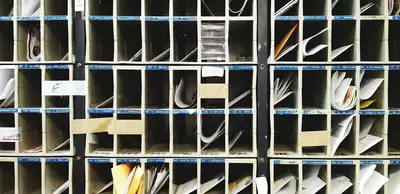

Reducing Small Business Costs:
A Guide to Shipping Best Practices
Discover how you can reduce shipping costs for your online business.
As a specialist in shipping and mailing, Pitney Bowes set out to see what challenges small online retailers faced when it came to mailing orders out to customers. Two key observations emerged when it came to small businesses and ecommerce shipping:
- Packaging boxes.
- That using shipping software can make a significant difference in the ease and shipping costs of sending packages.
Avoid overpackaging your online orders

Carriers like the USPS® don’t just charge based on weight and distance. They also take box size into account. Also known as Dimensional Rating (DIM), dimensions include the height, weight, width and length of the package, no matter what the contents are.
To reduce shipping costs that stem from DIM charges, consider the following:
- How many different types of boxes do you use? Can you reduce that number?
- Can you consolidate box sizes, so that you don’t need to measure each box?
- Are you shipping boxes with empty space and filler packaging materials?
- Can you use Flat Rate boxes provided by USPS and other carriers?
There are two packaging box options that fall within the sizing guidelines:
Folding Boxes
- Multi-depth brown corrugated shipping boxes designed to be cut to the size you need.
- Allows you to minimize the size of the package and reduce shipping costs.
- Designed to withstand high stacking and bursting weights.
USPS® Flat Rate Boxes
- These boxesoffer a fixed postage rate, as long as the weight remains under 70 lbs. and the contents fit into the box.
- The USPS® also offers regional rate pricing for Flat Rate Boxes and is available for Priority Mail® parcels as well as Merchandise Return Service (MRS), where parcels are returned at Priority Mail prices.
- Be sure this is the right shipping option for you, as in certain cases it may not be the most cost-effective method for shipping merchandise.
Choosing the right shipping option for small packages

For smaller packages weighing under 15.999 ounces, consider the First Class Package Service from the USPS.
As this type of shipment is non-personal correspondence, it qualifies for Commercial Base Pricing (CBP) rates.
Note: The First Class Package Service is NOT the same as First Class Mail Retail Parcel rates, which do not qualify for CBP rate discounts.
Small business shipping just got easier: New opportunities for low-volume shipping

Online shipping and sending software isn’t just for the big guys anymore, and it can make a significant difference in reducing both shipping costs and complexities for small ecommerce businesses. It can also enhance your professional image.
An online shipping software not only helps your small business create USPS-compliant shipping labels, it also provides the following benefits:
Real-time mail tracking:
By adding a pre-printed tracking label or a shipping label printed from a qualifying software, every package can be tracked from the moment it leaves until it’s delivered.
An online shipping software also provides you with complete tracking history and cost information for every order shipped within in a single suite, while comparing shipping rates across carriers.
A more professional image:
Shipping software enables you to print a full address label that includes your recipient’s address, the sender’s address (customized to your preference), and a tracking barcode.
A proper shipping label creates an impression of professionalism to your customers and tells them you know how to ship merchandise, putting them at ease.
Return shipping labels that can be prepared in advance for customers:
With an online shipping software, you can create a return label that can be emailed to your recipient to expedite a return.
Customers will feel comfortable shopping with your brand knowing that they can easily return an item if it’s not what they were looking for.